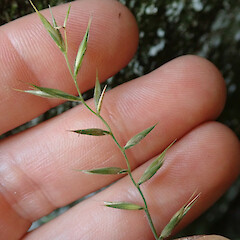Australopyrum calcis subsp. optatum
Common name
Canterbury limestone wheat grass
Synonyms
None
Family
Poaceae
Flora category
Vascular – Native
Endemic taxon
Yes
Endemic genus
No
Endemic family
No
Structural class
Grasses
NVS code
The National Vegetation Survey (NVS) Databank is a physical archive and electronic databank containing records of over 94,000 vegetation survey plots - including data from over 19,000 permanent plots. NVS maintains a standard set of species code abbreviations that correspond to standard scientific plant names from the Ngä Tipu o Aotearoa - New Zealand Plants database.
AUSOPT
Chromosome number
2n = 14
Current conservation status
The conservation status of all known New Zealand vascular plant taxa at the rank of species and below were reassessed in 2017 using the New Zealand Threat Classification System (NZTCS) – more information about this can be found on the NZTCS website. This report includes a statistical summary and brief notes on changes since 2012 and replaces all previous NZTCS lists for vascular plants.
Please note, threat classifications are often suggested by authors when publications fall between NZTCS assessment periods – an interim threat classification status has not been assessed by the NZTCS panel.
- Conservation status of New Zealand indigenous vascular plants, 2017 . 2018. Peter J. de Lange, Jeremy R. Rolfe, John W. Barkla, Shannel P. Courtney, Paul D. Champion, Leon R. Perrie, Sarah M. Beadel, Kerry A. Ford, Ilse Breitwieser, Ines Schönberger, Rowan Hindmarsh-Walls, Peter B. Heenan and Kate Ladley. Department of Conservation. Source: NZTCS and licensed by DOC for reuse under the Creative Commons Attribution 4.0 International licence.
2017 | Threatened – Nationally Endangered | Qualifiers: DP, RR
Previous conservation statuses
2012 | Threatened – Nationally Endangered | Qualifiers: RR
2009 | Threatened – Nationally Vulnerable | Qualifiers: RR
2004 | Threatened – Nationally Vulnerable
Distribution
Endemic. South Island. Canterbury. Known from Mt Cass, Castle Hill (where it is known from Castle Hill, Prebble Hill and Flock Hill) and from the Limestone Valley Road near Pleasant Point.
Habitat
A species of base-rich substrates and soils derived from these. Now only known from limestone outcrops where it grows under overhangs, in crevices or under shrubs and trees growing in and around the rock outcrops. One old herbarium specimen suggests it once grew on alluvial terraces.
Detailed description
Slender, stoloniferous red-green to dark green perennial grass. Leaf-sheath 25–50 mm, reddish green. Auricles 0.1–0.5 mm. Ligule 0.6–1.25 mm, lacerate. Collar dark brown to purple. Leaf-blade 60–250 × 0.5–3.5 mm, flat, thin, upper surface finely hairy on nerves; underside with conspicuous white midrib and 2 lateral ribs. Culm 170–600 mm, slender, reddish, nodes swollen, dark-brown to black, internodes glabrous with uppermost shortly-hairy. Inflorescence a spicate raceme 30–130 mm; spikelets 4–13, overlapping; rachis internodes shortly hairy, margins toothed. Spikelets 10–14 mm. Glumes unequal, lower 2.5–4 mm, upper 3.7–5.5 mm, narrowly to broadly-triangular, 3–5-nerved, undersides prickle toothed, upper invested with short white hairs. Lemma 9–11 m; undersides with stiff 0.3 mm long teeth, awn 1.5–4 mm. Palea 5.3–7 mm, apex bidid. Callus 0.25–0.4 mm upperside with short stiff hairs. Anthers 2.4–2.8 mm. Ovary 0.8–1 mm, stigma-styles 1.8–2 mm. Seed 3.5–4 mm, linear.
Manaaki Whenua Online Interactive Key
Similar taxa
Australopyrum calcis Connor et Molloy subsp. calcis is a larger, stouter grass. The upper surfaces of the leaves of this subspecies are glabrous (finely hairy in Australopyrum calcis subsp. optatum), while the culm internodes are glabrous (the uppermost is hairy in Australopyrum calcis subsp. calcis). The rachis internodes of Australopyrum calcis subsp. calcis are glabrous; in subsp. optatum they are finely hairy.
Flowering
October–December
Fruiting
November–February
Propagation technique
Easy from fresh seed. Does well in a sunny or semi-shaded location. Prefers a friable soil enriched in lime. Does best in a dry soil, disliking permanently damp conditions. Very shade tolerant but in such conditions it rarely flowers well.
Threats
Vulnerable to browsing animals damaging the shrublands shading the limestone overhangs in which this species grows, thereby allowing the spread of weed species and altering light levels, and although not especially palatable, plants are browsed. There is a total of perhaps 2000 plants: approximately 100 of these are at Mt Cass, and the largest sub-population of approximately 1000.
Attribution
Description modified from Edgar and Connor (2000).
References and further reading
Edgar E, Connor HE. 2000. Flora of New Zealand. Vol. V. Grasses. Christchurch, Manaaki Whenua Press. 650 p.










